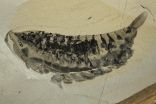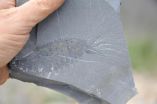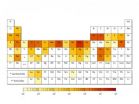(Press-News.org) TORONTO, ON - What do butterflies, spiders and lobsters have in common? They are all surviving relatives of a newly identified species called Yawunik kootenayi, a marine creature with two pairs of eyes and prominent grasping appendages that lived as much as 508 million years ago - more than 250 million years before the first dinosaur.
The fossil was identified by an international team led by palaeontologists at the University of Toronto (U of T) and the Royal Ontario Museum (ROM) in Toronto, as well as Pomona College in California. It is the first new species to be described from the Marble Canyon site, part of the renowned Canadian Burgess Shale fossil deposit.
Yawunik had evolved long frontal appendages that resemble the antennae of modern beetles or shrimps, though these appendages were composed of three long claws, two of which bore opposing rows of teeth that helped the animal catch its prey.
"This creature is expanding our perspective on the anatomy and predatory habits of the first arthropods, the group to which spiders and lobsters belong," said Cedric Aria, a PhD candidate in U of T's Department of Ecology & Evolutionary Biology and lead author of the resulting study published this week in Palaeontology. "It has the signature features of an arthropod with its external skeleton, segmented body and jointed appendages, but lacks certain advanced traits present in groups that survived until the present day. We say that it belongs to the 'stem' of arthropods."
The study presents evidence that Yawunik was capable of moving its frontal appendages backward and forward, spreading them out during an attack and then retracting them under its body when swimming. Coupled with the long, sensing whip-like flagella extending from the tip of the claws, this makes the frontal appendages of the animal some of the most versatile and complex in all known arthropods.
"Unlike insects or crustaceans, Yawunik did not possess additional appendages in the head that were specifically modified to process food," said Aria. "Evolution resulted here in a combination of adaptations onto the frontal-most appendage of this creature, maybe because such modifications were easier to acquire.
"We know that the larvae of certain crustaceans can use their antennae to both swim and gather food. But a large active predator such as a mantis shrimp has its sensory and grasping functions split up between appendages. Yawunik and its relatives tell us about the condition existing before such a division of tasks among parts of the organism took place."
The Marble Canyon site is located in British Columbia's Kootenay National Park, 40 kilometres south from the original Burgess Shale in Yoho National Park. Aria was part of the team that discovered the site in 2012, led by Jean-Bernard Caron, an associate professor at U of T's Departments of Earth Sciences and Ecology & Evolutionary Biology and curator of invertebrate palaeontology at the ROM, and Robert Gaines, associate professor at the Department of Geology at Pomona College in California, both co-authors of the study.
"Yawunik is the most abundant of the large new species of the Marble Canyon site, and so, as a predator, it held a key position in the food network and had an important impact on this past ecosystem," said Caron. "This animal is therefore important for the study of Marble Canyon, and shows how the site increases the significance of the Burgess Shale in understanding the dawn of animals."
The study benefited from cutting-edge techniques of fossil imagery, including so-called "elemental mapping," which consists in detecting the atomic composition of the fossil and the sediment surrounding it.
"Our understanding of these organisms rests upon interpreting their fossil remains," said Gaines. "These fossils are a composed of a mosaic of delicate original organic material and minerals that replicate parts of fossil anatomy.
"The scanning electron microscope allows us to make maps of the fossils that reveal their composition. This gives us a remarkable perspective on the fossils, allowing anatomical structures to be visualized more precisely. This technique also provides insight into the unusual fossilization process that was at work here."
The new creature is named in tribute to the Ktunaxa People who have long inhabited the Kootenay area where the Marble Canyon locality was found. It owes its name to "Yawu?nik?", a mythological figure described as a huge and fierce marine creature, killing and causing such mayhem that it triggered an epic hunt by other animals to bring the threat down.
"We wanted to acknowledge the Ktunaxa culture, and given the profile of Yawunik, it looked like a natural choice of name," Aria said.
"Yawu?nik? is a central figure in the Ktunaxa creation story, and, as such, is a vital part of Ktunaxa oral history," said Donald Sam, Ktunaxa Nation Council Director of Traditional Knowledge and Language. "I am ecstatic that the research team recognizes how important our history is in our territory, and chose to honour the Ktunaxa through this amazing discovery."
INFORMATION:
The research appears in a study titled "A large new leanchoiliid from the Burgess Shale and the influence of inapplicable states on stem arthropod phylogeny," published in Palaeontology. The material under study was collected in 2012 and fieldwork was mainly supported by the Royal Ontario Museum, Uppsala University and Pomona College. Aria's doctoral research is supported by a Natural Sciences and Engineering Research Council of Canada discovery grant to Jean-Bernard Caron and University of Toronto fellowships.
MEDIA CONTACTS:
Cedric Aria
Department of Ecology and Evolutionary Biology
University of Toronto
416-586-5593, Ext. 3
cedric.aria@yandex.com
Robert Gaines
Geology Department
Pomona College
909-621-8674
Robert.Gaines@pomona.edu
Sean Bettam
Communications, Faculty of Arts & Science
University of Toronto
416-946-7950
s.bettam@utoronto.ca
Cynthia Peters
Office of Communications
Pomona College
909-621-8515
cap04747@pomona.edu
Jesse Nicholas
Communications Manager
Ktunaxa Nation Council
250-489-2464, Ext. 3175
JNicholas@ktunaxa.org
Reclusive giant pandas fascinate the world, yet precious little is known about how they spend their time in the Chinese bamboo forests. Until now.
A team of Michigan State University (MSU) researchers who have been electronically stalking five pandas in the wild, courtesy of rare GPS collars, have finished crunching months of data and has published some panda surprises in this month's Journal of Mammalogy.
"Pandas are such an elusive species and it's very hard to observe them in wild, so we haven't had a good picture of where they are from one day to the next," said ...
Music performance is known to induce structural and functional changes to the human brain and enhance cognition. However, the molecular mechanisms underlying music performance have been so far unexplored. A Finnish research group has now investigated the effect of music performance (in a 2 hr concert) on the gene expression profiles of professional musicians from Tapiola Sinfonietta (a professional orchestra) and Sibelius-Academy (a music university).
Playing music enhanced the activity of genes involved in dopaminergic neurotransmission, motor function, learning and ...
In a new paper, a team of Yale researchers assesses the "criticality" of all 62 metals on the Periodic Table of Elements, providing key insights into which materials might become more difficult to find in the coming decades, which ones will exact the highest environmental costs -- and which ones simply cannot be replaced as components of vital technologies.
During the past decade, sporadic shortages of metals needed to create a wide range of high-tech products have inspired attempts to quantify the criticality of these materials, defined by the relative importance of ...
A new study from SciLifeLab at Uppsala University published in PLOS ONE shows that genes crucial for vision were multiplied in the early stages of vertebrate evolution and acquired distinct functions leading to the sophisticated mechanisms of vertebrate eyes.
One striking feature of vertebrates is the prominent role that vision plays in almost all major animal groups. The vertebrate eye has a unique organization and is known to have arisen at the time of the first vertebrates over 500 million years ago. A new study by the research team led by Xesús Abalo and Dan ...
Antioxidants provide long-term protection against the chain reactions of free radical processes, in other words, of the molecules that are capable of causing cell damage and generating various diseases. Free radicals harm our body by causing, in the best of cases, ageing and, in the worse, serious diseases. Lettuce is rich in antioxidants, as it contains compounds like phenolic acids, flavonoids, anthocyanins, and vitamins A and C, among other things.
Green, semi-red and red leaves
To conduct this research, which started in 2011 and in which researchers of the UPV/EHU ...
Washington, DC, March 27, 2015 - Patients with Clostridium difficile infection (CDI) are twice as likely to be readmitted to the hospital as patients without the deadly diarrheal infection, according to a study published in the April issue of the American Journal of Infection Control, the official publication of the Association for Professionals in Infection Control and Epidemiology (APIC).
Researchers from the Detroit Medical Center (DMC), a seven-hospital system in southeastern Michigan, conducted a large study to understand the epidemiology of CDI readmissions, analyzing ...
Two scientific studies led by researchers at Sweden's Karolinska Institutet are expected to form the basis of new international recommendations for the treatment of medical abortions and miscarriages. One of the studies, both of which are being published in the journal The Lancet, shows that it is possible to replace the clinical follow-up examinations recommended today with medical abortions that include a home pregnancy test. The other study shows that midwives can safely and effectively treat failed abortions and miscarriages in rural districts of Uganda.
The term ...
Using a simulation model, Swedish researchers have shown that the implementation of Fracture Liaison Services (FLS) could considerably reduce the human and healthcare costs associated with osteoporotic fractures. The results from the model were presented today at the World Congress on Osteoporosis, Osteoarthritis and Musculoskeletal Diseases in Milan.
FLS are coordinated, multi-disciplinary models of care which help ensure that fracture patients are assessed and treated to reduce their risk of subsequent fractures. According to expert opinion and the International Osteoporosis ...
Big data: It's a term we read and hear about often, but is hard to grasp. Computer scientists at Washington University in St. Louis' School of Engineering & Applied Science tackled some big data about an important protein and discovered its connection in human history as well as clues about its role in complex neurological diseases.
Through a novel method of analyzing these big data, Sharlee Climer, PhD, research assistant professor in computer science, and Weixiong Zhang, PhD, professor of computer science and of genetics at the School of Medicine, discovered a region ...
March 27, 2015 (Las Vegas, Nevada) A new study from researchers at NYU Langone's Hospital for Joint Diseases identifies common causes of hospital readmissions following total hip and knee arthoplasty procedures. By finding these common causes, researchers believe quality can be increased and hospital costs decreased.
The study will be presented Friday, March 27, 2015 at the American Academy of Orthopaedic Surgeons Annual Meeting in Las Vegas.
The patients were part of the Bundled Payment for Care Initiative from the Centers for Medicare and Medicaid Services (CMS), ...




